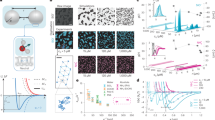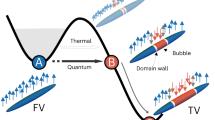Abstract
VAN DER ZIEL1 has observed weak predissociation in the First Positive system of N2 for bands with v′ greater than 11. The predissociation was reported to be of the type which increases in strength with the rotational quantum number J, and both λ doubling components of the B3Πg state are affected. Van der Ziel therefore concluded, apparently with good reason, that the state causing the predissociation was of type Δ. This led to the conclusion that a dissociation limit, the products of which were capable of producing a Δ state, must lie below the energy of the predissociation. Combining this information with the known predissociation limit for the C3Πu state at 12·145 e.v., this gave a value of 7·383 e.v. for the dissociation energy of nitrogen, a value which has been generally accepted.
This is a preview of subscription content, access via your institution
Access options
Subscribe to this journal
Receive 51 print issues and online access
$199.00 per year
only $3.90 per issue
Buy this article
- Purchase on Springer Link
- Instant access to full article PDF
Prices may be subject to local taxes which are calculated during checkout
Similar content being viewed by others
References
Van der Ziel, A., Physica, 4, 373 (1937).
Gaydon, A. G., and Penney, W. G., NATURE, 150, 406 (1942).
Pearse, R. W. B., Proc. Roy. Soc., A, 122, 442 (1929).
Author information
Authors and Affiliations
Rights and permissions
About this article
Cite this article
GAYDON, A. Dissociation Energy of Nitrogen. Nature 153, 407–408 (1944). https://doi.org/10.1038/153407b0
Issue Date:
DOI: https://doi.org/10.1038/153407b0
This article is cited by
-
The positive column of high- and low-current arcs
Applied Scientific Research, Section B (1956)
-
The Positive Column of High- and Low- Current Arcs
Nature (1954)
-
Atomic Nitrogen in Auroras
Nature (1951)
-
Zur Dissoziationsenergie des Fluors
Die Naturwissenschaften (1950)
-
Trennungsenergien in organischen Molekeln
Die Naturwissenschaften (1948)
Comments
By submitting a comment you agree to abide by our Terms and Community Guidelines. If you find something abusive or that does not comply with our terms or guidelines please flag it as inappropriate.



